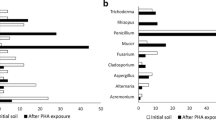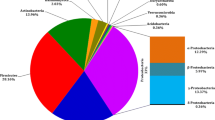Abstract
To determine the liquid culture conditions under which the wood-degrading system of the brown-rot fungus Gloeophyllum trabeum is expressed, enzymes and metabolites from liquid and solid substrate cultures were characterized. Enzymes were analyzed by 2-D gel electrophoresis and also assayed. Growth conditions were varied by using liquid media containing: (1) low carbon, low nitrogen, (2) low carbon, high nitrogen, (3) high carbon, low nitrogen, or (4) high carbon, high nitrogen. The protein arrays expressed under the four conditions were very similar, and endo-1,4-β-glucanase (detected by 2-D gels) activity along with β-glucosidase, xylanase, and NADH/quinone oxidoreductase activities were detected. Maximal expression of the hydrolytic enzymes was observed in high carbon/high nitrogen medium, whereas the highest oxidoreductase activity was in the high carbon low nitrogen medium. Oxalate and 2,5-dimethoxybenzoquinone were detected under all culture conditions, with higher production in high carbon/low nitrogen medium. Cultures grown in this medium also yielded the highest rate of hydroxylation of p-hydroxybenzoic acid, yielding protocatechuic acid, a product of hydroxyl radical attack.



Similar content being viewed by others
Abbreviations
- DMBQ :
-
2,5-Dimethoxybenzoquinone
- HC/HN :
-
High carbon/high nitrogen
- HC/LN :
-
High carbon/low nitrogen
- LC/HN :
-
Low carbon/high nitrogen
- LC/LN :
-
Low carbon/low nitrogen
Refrences
Bailey MJ, Biely P, Poutanen K (1992) Interlaboratory testing of methods for assay of xylanase activity. J Biotechnol 23:257-270
Biely P, Markovic O, Mislovicova D (1985) Sensitive detection of endo-1,4-beta-glucanases and endo-1,4-beta-xylanases in gels. Anal Biochem 144:147-151
Cotoras M, Agosin E (1992) Regulatory aspects of endoglucanase production by the brown-rot fungus Gloeophyllum-trabeum. Exp Mycol 16:253-260
Cowling EB (1961) Comparative biochemistry of sweetgum sapwood by white rot and brown rot fungi. In: USDA Tech. Bull. #1258. US Department of Agriculture, Washington, DC, p. 79
Dutton MV, Evans CS, Atkey PT, Wood DA (1993) Oxalate production by basidiomycetes, including the white-rot species Coriolus versicolor and Phanerochaete chrysosporium. Appl Microbiol Biotechnol 39:5-10
Enoki AT, Hirano T, Tanaka H (1992) Extracellular substances from the brown-rot basidiomycete Gloeophyllum trabeum that produces and reduces hydrogen peroxide. Mater Org 27:247-161
Glenn JK, Morgan MA, Mayfield MB, Kuwahara M, Gold MH (1983) An extracellular H2O2-requiring enzyme preparation involved in lignin biodegradation by the white rot basidiomycete Phanerochaete chrysosporium. Biochem Biophys Res Commun 114:1077-1083
Green I, F., Highley TL (1997) Mechanism of brown rot decay: paradigm or paradox. Int Biodeter Biodegr 39:113-124
Guillen F, Gomez-Toribio V, Martinez MJ, Martinez AT (2000) Production of hydroxyl radical by the synergistic action of fungal laccase and aryl alcohol oxidase. Arch Biochem Biophys 383:142-147
Highley TL (1973) Influence of carbon source on cellulase activity of white-rot and brown-rot fungi. Wood Fiber 5:50-58
Hirano T, Tanaka H, Enoki A (1995) Extracellular substance from the brown rot basidiomycete Tyromycetes palustris that reduces molecular oxygen to hydroxyl radicals and ferric iron to ferrous iron. Mokuzai Gakkaishi 41:334-341
Jeffries TW, Choi WS, Kirk TK (1981) Nutritional regulation of lignin degradation. Appl Environ Microbiol 42:290-296
Jensen KA, Jr., Houtman CJ, Ryan ZC, Hammel KE (2001) Pathways for extracellular Fenton chemistry in the brown rot basidiomycete Gloeophyllum trabeum. Appl Environ Microbiol 67:2705-2711
Jensen KA, Jr., Ryan ZC, Vanden Wymelenberg A, Cullen D, Hammel KE (2002) An NADH:quinone oxidoreductase active during biodegradation by the brown-rot basidiomycete Gloeophyllum trabeum. Appl Environ Microbiol 68:2699-2703
Kamada F, Abe S, Hiratsuka N, Wariishi H, Tanaka H (2002) Mineralization of aromatic compounds by brown-rot basidiomycetes - mechanisms involved in initial attack on the aromatic ring. Microbiology 148:1939-1946
Kerem Z, Bao W, Hammel KE (1998) Rapid polyether cleavage via extracellular one-electron oxidation by a brown-rot basidiomycete. Proc. Natl. Acad. Sci. U. S. A. 95:10373-10377
Kerem Z, Jensen KA, Jr., Hammel KE (1999) Biodegradative mechanism of the brown rot basidiomycete Gloeophyllum trabeum: evidence for an extracellular hydroquinone-driven Fenton reaction. FEBS Lett. 446:49-54
Keyser P, Kirk TK, Zeikus JG (1978) Ligninolytic enzyme system of Phanaerochaete chrysosporium: synthesized in the absence of lignin in response to nitrogen starvation. J. Bacteriol. 135:790-797
Kirk TK, Highley TL (1973) Quantitative changes in structural components of coniferyl woods during decay by white rot and brown rot fungi. Phytopathology 63:1338-1342
Kirk TK, Shimada M (1985) Lignin biodegradation: the microorganisms involved and the physiology and biochemistry of the white-rot fungi. In: Higuchi T (ed) Biosynthesis and biodegradation of wood components. Academic, New York, pp 579-605
Kirk TK, Farrell RL (1987) Enzymatic "combustion": the microbial degradation of lignin. Annu Rev Microbiol 41:465-505
Koenigs JW (1972) Production of extracellular hydrogen peroxide and peroxidase by wood-rotting fungi. Phytopathology 62:100-110
Laemmli UK (1970) Cleavage of structural protein during the head of bacteriophage T4. Nature 227:680-685
Mansfield SD, Saddler JN, Gubitz GM (1998) Characterization of endoglucanases from the brown rot fungi Gloeophyllum sepiarium and Gloeophyllum trabeum. Enzyme Microb Technol 23:133-140
Miller GL (1959) Use of dinitrosalicylic acid reagent for determination of reducing sugars. Anal Chem 31:426-428
Newcombe D, Paszczynski A, Gajewska W, Kroger M, Feis G, Crawford R (2002) Production of small molecular weight catalysts and the mechanism of trinitrotoluene degradation by several Gloeophyllum species. Enzyme Microb Technol 30:506-517
Paszczynski A, Crawford R, Funk D, Goodell B (1999) De novo synthesis of 4,5-dimethoxycatechol and 2, 5-dimethoxyhydroquinone by the brown rot fungus Gloeophyllum trabeum. Appl Environ Microbiol 65:674-679
Ritschkoff AC, Buchert J, Viikari L (1994) Purification and characterization of a thermophilic xylanase from the brown-rot fungus Gloeophyllum trabeum. J Biotechnol 32:67-74
Schmidt CJ, Whitten BK, Nicholas DD (1981) A proposed role for oxalic acid in non-enzymatic wood decay by brown rot fungi. Agric Biol Chem 40:811-812
Shimada M, Akamtsu Y, Tokimatsu T, Mii K, Hattori T (1997) Possible biochemical roles of oxalic acid as a low molecular weight compound involved in brown-rot and white-rot wood decays. J Biotechnol 53:103-113
Tanaka H, Itakura S, Enoki A (1999) Hydroxyl radical generation by an extracellular low-molecular-weight substance and phenol oxidase activity during wood degradation by the white-rot basidiomycete Trametes versicolor. Biotechnology 75:57-70
Tanaka N, Akamatsu Y, Hattori T, Shimada M (1994) Effect of oxalic acid on the oxidative breakdown of cellulose by the Fenton reaction. Wood Res 81:8-10
Tien M, Kirk TK (1983) Lignin-degrading enzyme from the Hymenomycete Phanerochaete chrysosporium Burds. Science 221:661-663
Tien M, Kirk TK (1988) Lignin peroxidase of Phanerochaete chrysosporium. Methods Enzymol 161:238-249
Wang W, Gao PJ (2002) A peptide-mediated and hydroxyl radical HO*-involved oxidative degradation of cellulose by brown-rot fungi. Biodegradation 13:383-394
Wang W, Gao PJ (2003) Function and mechanism of a low-molecular-weight peptide produced by Gloeophyllum trabeum in biodegradation of cellulose. J Biotechnol 101:119-130
Wei DL, Kirimura K, Usami S, Lin TH (1996) Purification and characterization of an extracellular beta-glucosidase from the wood-grown fungus Xylaria regalis. Curr Microbiol 33:297-301
Winandy JE, Morrell JJ (1993) Relationship between incipient decay, strength, and chemical composition of Douglas-fir heartwood. Wood Fiber Science 25:278-288
Xu G, Goodell B (2001) Mechanisms of wood degradation by brown-rot fungi: chelator-mediated cellulose degradation and binding of iron by cellulose. J Biotechnol 87:43-57
Acknowledgements
This work was supported in part by U.S. Department of Energy grant DE-FG02–87ER13690.
Author information
Authors and Affiliations
Corresponding author
Rights and permissions
About this article
Cite this article
Varela, E., Mester, T. & Tien, M. Culture conditions affecting biodegradation components of the brown-rot fungus Gloeophyllum trabeum . Arch Microbiol 180, 251–256 (2003). https://doi.org/10.1007/s00203-003-0583-y
Received:
Revised:
Accepted:
Published:
Issue Date:
DOI: https://doi.org/10.1007/s00203-003-0583-y




